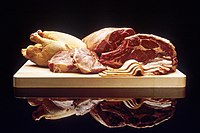
Photo from wikipedia
Meat and meat products are a fundamental part of the human diet. The protein and vitamin content, as well as essential fatty acids, gives them an appropriate composition to complete… Click to show full abstract
Meat and meat products are a fundamental part of the human diet. The protein and vitamin content, as well as essential fatty acids, gives them an appropriate composition to complete the nutritional requirements. However, meat constituents are susceptible to degradation processes. Among them, the most important, after microbial deterioration, are oxidative processes, which affect lipids, pigments, proteins and vitamins. During these reactions a sensory degradation of the product occurs, causing consumer rejection. In addition, there is a nutritional loss that leads to the formation of toxic substances, so the control of oxidative processes is of vital importance for the meat industry. Nonetheless, despite lipid oxidation being widely investigated for decades, the complex reactions involved in the process, as well as the different pathways and factors that influenced them, make that lipid oxidation mechanisms have not yet been completely understood. Thus, this article reviews the fundamental mechanisms of lipid oxidation, the most important oxidative reactions, the main factors that influence lipid oxidation, and the routine methods to measure compounds derived from lipid oxidation in meat.
Journal Title: Antioxidants
Year Published: 2019
Link to full text (if available)
Share on Social Media: Sign Up to like & get
recommendations!